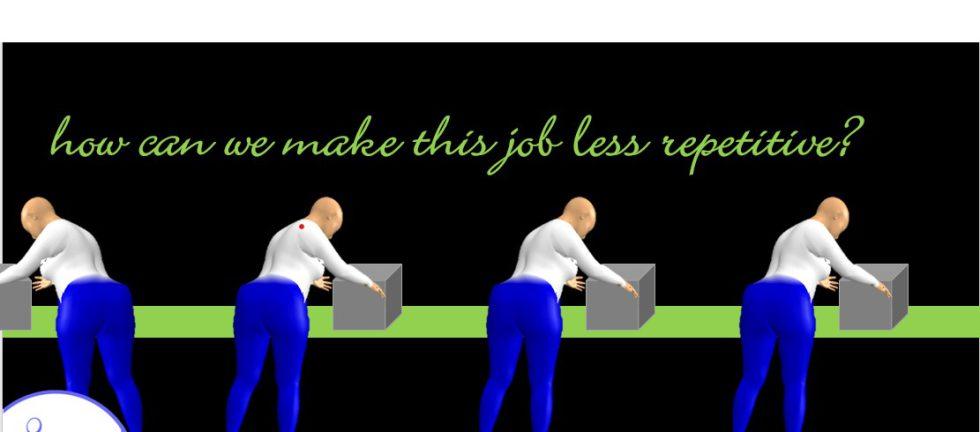Work is “repetitive” in many work environments. People package and palletize, load presses, use paint guns, and more . After an injury occurs, an employee’s health care provider may limit the employee from “repetitive” work. In a workplace where thousands of items are produced per shift, how can you find work that is not “repetitive”?
What does “repetitive” really mean? It’s all about awkward body positions. When people refer to “repetitive back bending” or “repetitive wrist movement”, they are considering how often the body part or joint bends into an awkward posture. If the wrist is straight, a job that is performed frequently can still be free from repetitive wrist movement.
Some people and organizations use the criteria “rarely, occasionally, frequently, and constantly” to categorize demands. This would be helpful if the options were defined in terms of movement frequency (number of movements per minute) and if the forms used by healthcare providers also offered the same options. These categories are often defined in terms of exposure duration, not frequency. (e.g., ohcow.on.ca) “Occasional” is typically defined as less than 33% of the shift. If I lift an object once every minute all day long, and it takes 3 seconds, do I lift “constantly” because I lift all day long, or “occasionally” because the lift requires only 3 seconds out of 60? (Only 5% of my shift is spent lifting.) If these categories are used in your organization, make sure everyone is using them consistently.
In Ontario, the WSIB’s functional abilities form (Functional Abilities Form (wsib.ca) allows health care providers to limit employees from “repetitive” work for a specific body part. However, the form does not provide a definition for “repetitive”.
Our answer to this problem is to report, for cyclic jobs such as packagers or palletizers, how many times per minute each joint bends. The palletizer on a line producing 880 units per shift might bend the back twice per minute, for example. We can’t measure movement frequency for jobs with long cycles such as mechanics and nurses, but we can flag body parts that are required to work “repetitively” for certain tasks. Our thresholds for “repetitive” are identified in our physical and cognitive demands analysis report.
Did you know? Not all repetitive jobs require repetitive demands. It is possible for a worker to load parts into a press at a rate of 4 parts per minute without repetitively bending, reaching, wrist bending, or pinching, if the workstation is designed well.
So, back to our question….how can we make a job less repetitive?
- Eliminate the awkward postures. Palletizing onto a pallet on the floor might require repetitive bending, but you might be able to eliminate this demand by raising the pallet on a lift table. Packaging might require repetitive reaching, but this might be eliminated with diverters or narrower conveyors. “Repetition” refers to repeated awkward postures; if you fix the postures, you can eliminate the repetitive demands!
- Use job rotation. It has been argued that job rotation spreads risk amongst more workers and, for heavy tasks that may be true. But we believe that rotation can limit exposure to repetitive demands. If I have to bend my back repetitively at one job in my department, I’d rather do that job for 1 hour per day than 8. (The ergonomist in me would rather get rid of the bending, but I digress….) The trick is to rotate amongst jobs with different demands.
- Encourage better work practices. Particularly during training, encourage workers to use both hands, alternatively. Many people underutilize their left hand, and overuse their right. If you learn to use a new tool with both hands, you’ll be able to “average” the demands between your hands. When we encourage experienced operators to show us their tips and tricks, we find that many of them have figured out ways to do jobs with less effort; finding, documenting, and sharing these “best practices” can help new workers more easily adapt to new jobs.
Eventually, many repetitive jobs will be automated. For now, we still need humans to bend, reach, grip, and pinch. Let’s try to minimize how awkward and repetitive that is!
Need help with your physical and cognitive demands analyses? Contact carrie@taylordergo.com
Want to learn how to do physical and cognitive demands analyses? Register for our September course, here.
Want help identifying and documenting best practices? Learn more here, and contact carrie@taylordergo.com for a quote.


